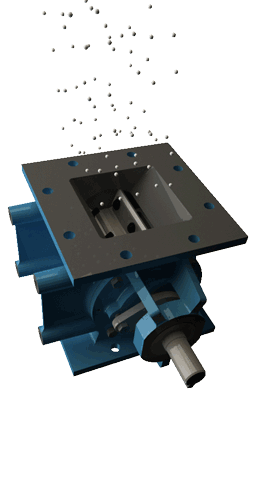BULK HANDLING INDUSTRIES
Rotary valves are manufactured for the powder and bulk handling industries worldwide
Rotary Valves are basically used as components in a bulk or specialty material handling systems. Rotary feeders are primarily used for discharge of bulk solid material from hoppers/bins, receivers, and cyclones into a pressure or vacuum-driven pneumatic conveying system. Components of a rotary feeder include a rotor shaft, housing, head plates, and packing seals and bearings.
HISTORY
Now we know what rotary valves are made up of and what it is that they do. The next question is how they do it. Before coming to the how of it, let us turn a few pages of history and see the how and why of the time they came into existence.
Stölzel valve
You would assume that valves were first used in a far off land in some industry not well known, but, that is not the case. In reality the first time a valve was used was in a musical instrument just at the beginning of the 19th century.
It was known as the Stölzel valve, named after its inventor Heinrich Stölzel, who invented this valve in 1814. Even though Heinrich was the one who invented the first valve Joseph Riedl is credited with the first use of rotary valves on brass instruments in 1832.

Combustion Engines
Apart from the musical instruments, rotary valves have been extensively used in the combustion engines. For almost all its history, the preferred valve for the Internal Combustion engine has been the poppet type. However, many inventors have been attracted by the apparent simplicity and the uniform motion of rotary valves of one kind or another.
There is also the tempting prospect of being able to run on inferior fuels because there was no hot exhaust valve always present in the cylinder to trigger pre-ignition. However, as with both steam and IC rotary engines, the simplicity was more apparent than real and the engineering problems were daunting.
Schemes Patents
There were a large number of rotary valve schemes tried, many of which are only known as patents, the practical success or otherwise being lost to history. The first US patents tracked down so far are by Frayer & Howard in 1907 and 1908. Another early patent was in 1911 by Vallillee who used a rotating disc.
Rotary valves were also tried in steam engines, without conspicuous success.
It was much later that the valves made their way into the industries and the rotary valves we so commonly see in the bulk handling industries made such an impact that we can no longer imagine an industry that does not make use of these valves.
FUNCTIONS
 Now that we are all caught up with the history lesson, we will shed some light on how the rotary valves work and furthermore, where they are most commonly used. We already know what a rotary valve is and we looked at a list of the functions it can perform. It is not only limited to one of those functions but can satisfy any combination of these needs.
Now that we are all caught up with the history lesson, we will shed some light on how the rotary valves work and furthermore, where they are most commonly used. We already know what a rotary valve is and we looked at a list of the functions it can perform. It is not only limited to one of those functions but can satisfy any combination of these needs.
Some of the important aspects that need to be kept in mind while using a system that incorporates a rotary valve are described below:
- Rotary Valves does not create product flow; it can only pass such product that can fall into it and out of it under gravity.
- All Rotary Valves leak air (or gas) when the system is operating (regardless of whether there is a pressure differential or not) and this can affect product flow and system performance, especially where the gas pressure below the valve is the greater.
- The faster the rotor speed the lower and more erratic the filling efficiency.
- The greater the pressure differential across the Rotor the less predictable and less stable the filling efficiency.
These factors mean that:-
- The performance of Rotary Valves is affected by the design and performance of the system, and vice versa.
- The selection of Valve speed and size is not a precise science. They are selected by taking into account the various factors that may negatively affect Valve performance from the theoretical maximum.
Rotary valves are an important part of the bulk handling industry, if not the most essential. The beauty of it is that their design is so simple yet so efficient that there hasn’t been another product that has even come close to replacing rotary valves and it does not look like that they will be replaced anytime soon in the near future.





